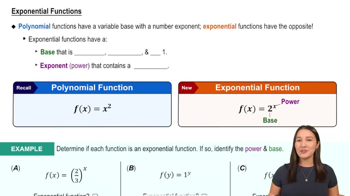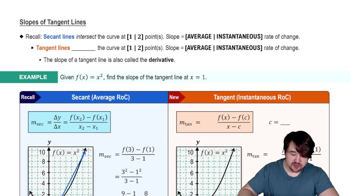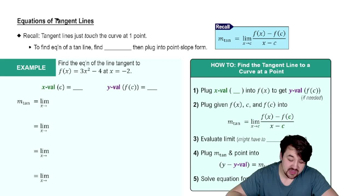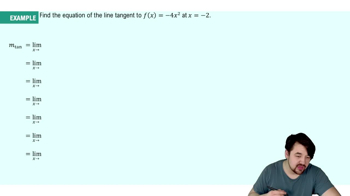Table of contents
- 0. Functions7h 52m
- Introduction to Functions16m
- Piecewise Functions10m
- Properties of Functions9m
- Common Functions1h 8m
- Transformations5m
- Combining Functions27m
- Exponent rules32m
- Exponential Functions28m
- Logarithmic Functions24m
- Properties of Logarithms34m
- Exponential & Logarithmic Equations35m
- Introduction to Trigonometric Functions38m
- Graphs of Trigonometric Functions44m
- Trigonometric Identities47m
- Inverse Trigonometric Functions48m
- 1. Limits and Continuity2h 2m
- 2. Intro to Derivatives1h 33m
- 3. Techniques of Differentiation3h 18m
- 4. Applications of Derivatives2h 38m
- 5. Graphical Applications of Derivatives6h 2m
- 6. Derivatives of Inverse, Exponential, & Logarithmic Functions2h 37m
- 7. Antiderivatives & Indefinite Integrals1h 26m
2. Intro to Derivatives
Tangent Lines and Derivatives
Problem 108
Textbook Question
Use the definition of the derivative to evaluate the following limits.
 Verified step by step guidance
Verified step by step guidance1
Recognize that the limit \( \lim_{x\to2}\frac{5^{x}-25}{x-2} \) is in the indeterminate form \( \frac{0}{0} \), which suggests using L'Hôpital's Rule or algebraic manipulation.
Rewrite the expression \( 5^x - 25 \) as \( 5^x - 5^2 \) to identify a common factor.
Factor the numerator as a difference of powers: \( 5^x - 5^2 = (5-5)(5^{x-1} + 5^{x-2} \cdot 5 + \ldots + 5^2) \).
Apply L'Hôpital's Rule, which involves differentiating the numerator and the denominator separately: differentiate \( 5^x \) to get \( 5^x \ln(5) \) and \( x-2 \) to get 1.
Evaluate the new limit \( \lim_{x\to2}\frac{5^x \ln(5)}{1} \) by substituting \( x = 2 \) into the expression.
Recommended similar problem, with video answer:
 Verified Solution
Verified SolutionThis video solution was recommended by our tutors as helpful for the problem above
Video duration:
1mPlay a video:
Was this helpful?
Key Concepts
Here are the essential concepts you must grasp in order to answer the question correctly.
Definition of the Derivative
The derivative of a function at a point is defined as the limit of the average rate of change of the function as the interval approaches zero. Mathematically, it is expressed as f'(a) = lim (h→0) [f(a+h) - f(a)] / h. This concept is fundamental for evaluating limits that represent the slope of the tangent line to the curve at a specific point.
Recommended video:

Derivatives
Limit Evaluation
Limits are used to analyze the behavior of functions as they approach a certain point. In this context, we are interested in the limit as x approaches 2 for the expression (5^x - 25) / (x - 2). Evaluating this limit often involves techniques such as direct substitution, factoring, or applying L'Hôpital's Rule when the limit results in an indeterminate form.
Recommended video:

One-Sided Limits
Exponential Functions
Exponential functions, such as 5^x, are functions where a constant base is raised to a variable exponent. They exhibit unique properties, including rapid growth and specific limits as x approaches certain values. Understanding the behavior of exponential functions is crucial for evaluating limits involving expressions like 5^x, especially when determining continuity and differentiability at specific points.
Recommended video:

Exponential Functions

 5:13m
5:13mWatch next
Master Slopes of Tangent Lines with a bite sized video explanation from Nick
Start learningRelated Videos
Related Practice




